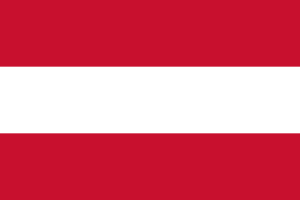Flags and coats of arms of the countries of Austria

This list of flags of Austrian countries shows all flags of the Austrian countries as well as their coats of arms.
In some federal states, a distinction is made between the state flags and the official flags . The latter may only be hoisted by the relevant state authorities. The display of the official flags as part of an encyclopedic work is permitted. Most of the flags of the federal states are based on the local coat of arms. In many cases, they existed before they were officially introduced.
In Austria, in addition to the rectangular flags shown here , vertical rectangular flag variants ( hanging flags , banners , flapping flags) are very often in use.
Flags and coats of arms
| location | Country flag | Service flag | coat of arms | Explanations |
|---|---|---|---|---|

|

|

|

|
The Burgenland flag was officially introduced on June 25, 1921 and is older than the coat of arms. Both are based on the mythical coats of arms of the vandals , who lived in the area in the 4th century and wielded a golden dragon on a red cloth. The coat of arms of Burgenland was established in 1922 and is a combination of the coat of arms of the Counts of Güssing-Bernstein (heart shield) and the Counts of Mattersdorf-Forchtenstein in different colors. |

|

|

|

|
The flag of Carinthia dates from 1946 and combines the colors of Austria with the yellow state shield. The shield of the Carinthian coat of arms is split in gold and red; in front are three black, red-tongued and armed lions one above the other, behind a silver bar. The crowned tournament helmet with red and gold covers has two golden buffalo horns, each with five golden sticks on the outside, three black linden leaves hanging down on the right and three red on the left. |

|

|

|

|
The flag of Lower Austria was officially introduced on August 9, 1954. The Lower Austrian coat of arms was laid down in the Provincial Constitutional Act of 1920: “ five golden eagles in a blue shield ”. It appears as the legendary coat of arms of Saint Leopold as early as 1335 . Duke Rudolf IV then established it in 1360 as the coat of arms of Old Austria next to the shield. |

|

|

|

|
The flag of Upper Austria was officially introduced on April 25, 1949. The Upper Austrian coat of arms , established in 1930, shows a golden eagle in the split shield in front in black, in the back split three times in silver and red. The Austrian Archduke's hat rests on the shield . |

|

|

|

|
Salzburg put its flag into use on February 16, 1921. At the same time, Salzburg also determined its coat of arms : split in gold and red, a black lion in front, a silver bar in the back. A prince's hat lies on the shield . This coat of arms can be traced back to around 1290 and has been used regularly since the 14th century. The red- silver- red in the coat of arms is probably not related to the Babenberg shield (which the Habsburgs later used for part of the Austrian country and as a naval war flag) and is of unknown origin. |

|

|

|

|
The white and green flag of Styria was introduced in 1960. The Styrian coat of arms is laid down in the State Constitutional Law of 1926: "In green, a silver fire-breathing panther". The Styrian ducal hat rests on the shield. The panther can already be traced on a ducal seal of Ottokar from the 12th century. It was probably intended as a distinguishing feature to Austria in Babenberg . |

|

|

|

|
The flag of Tyrol was officially introduced on March 10, 1949. The Tyrolean coat of arms was established in 1946. The Tyrolean eagle appears on coins from 1250. The oldest colored depiction dates from 1340. The crown dates from 1416, but the wreath from 1567 only became an official part of the coat of arms around 1920. |

|

|

|

|
The Vorarlberg state flag is identical to the flags of Vienna and Salzburg. In those of Tyrol and Upper Austria, the color relationships are reversed. The Vorarlberg coat of arms goes back to the medieval Montfort family. It is the only coat of arms of an Austrian federal state in which there is no heraldic animal (in Vienna, however, an eagle is only used in the large coat of arms). |

|

|

|

|
Vienna has had the red and white colors since 1844, but the current flag was only introduced in 1946. With the reintroduction of the flag, the Vienna coat of arms with a silver cross in red was reinstated. A cross shield appeared for the first time in 1278 on a Viennese pfennig , probably it comes from the imperial storm flag. In 1924 the double eagle on the Viennese coat of arms was replaced by the single eagle, which is still valid today, and which looks west. |
See also
literature
- Karl-Heinz Hesmer: Flags and coats of arms of the world. With current country information . Gütersloh: Chronik Verlag, 2008. ISBN 3-577-14537-4
- The Flag Institute: National flags of the world . Hamburg: Edition Maritim, 2000. ISBN 3-89225-402-8